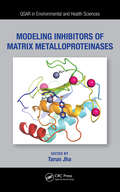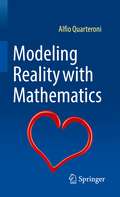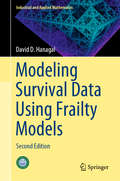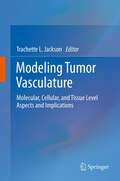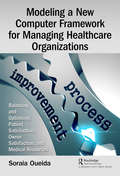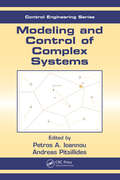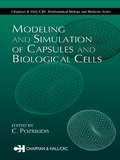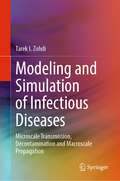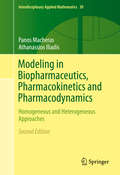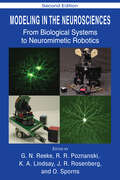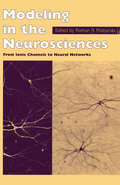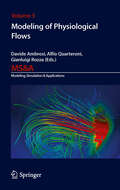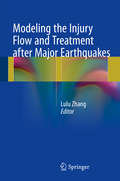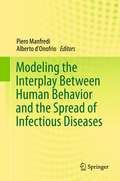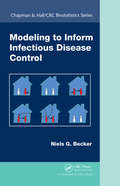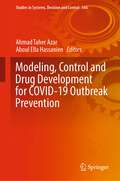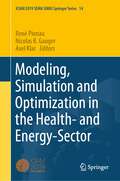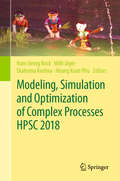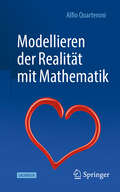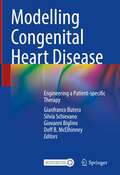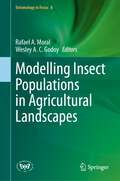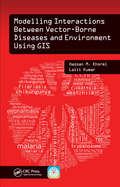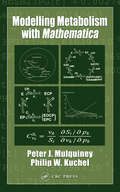- Table View
- List View
Modeling Inhibitors of Matrix Metalloproteinases (QSAR in Environmental and Health Sciences)
by Tarun JhaMatrix metalloproteinases (MMPs) have been established as promising biomolecular targets for novel drug design and discovery against numerous major disease conditions including various cancers, cardiovascular, neurodegenerative, inflammatory diseases, and more. This book covers various modern molecular modeling methodologies particularly related to MMP inhibitors. Included in the text are descriptions of ligand-based drug designing and structure-based drug designing modeling strategies for designing potential and target specific or selective MMPIs. This book will benefit those who are looking for an in-depth text on the design and discovery processes of novel and selective MMPIs. Features Describes modeling strategies applied to MMPs Elaborates on the designing strategies of MMPs specifically Includes in-depth analyses of related case studies Acts as a guide for medicinal chemists, not only from pharmaceutical industries, but also from academia Covers various modern molecular modeling methodologies, particularly related to MMPIs
Modeling Phase Transitions in the Brain
by D. Alistair Steyn-Ross Moira Steyn-Ross Walter FreemanForeword by Walter J. Freeman. The induction of unconsciousness using anesthetic agents demonstrates that the cerebral cortex can operate in two very different behavioral modes: alert and responsive vs. unaware and quiescent. But the states of wakefulness and sleep are not single-neuron properties---they emerge as bulk properties of cooperating populations of neurons, with the switchover between states being similar to the physical change of phase observed when water freezes or ice melts. Some brain-state transitions, such as sleep cycling, anesthetic induction, epileptic seizure, are obvious and detected readily with a few EEG electrodes; others, such as the emergence of gamma rhythms during cognition, or the ultra-slow BOLD rhythms of relaxed free-association, are much more subtle. The unifying theme of this book is the notion that all of these bulk changes in brain behavior can be treated as phase transitions between distinct brain states. Modeling Phase Transitions in the Brain contains chapter contributions from leading researchers who apply state-space methods, network models, and biophysically-motivated continuum approaches to investigate a range of neuroscientifically relevant problems that include analysis of nonstationary EEG time-series; network topologies that limit epileptic spreading; saddle--node bifurcations for anesthesia, sleep-cycling, and the wake--sleep switch; prediction of dynamical and noise-induced spatiotemporal instabilities underlying BOLD, alpha-, and gamma-band Hopf oscillations, gap-junction-moderated Turing structures, and Hopf-Turing interactions leading to cortical waves.
Modeling Reality with Mathematics
by Alfio QuarteroniSimulating the behavior of a human heart, predicting tomorrow's weather, optimizing the aerodynamics of a sailboat, finding the ideal cooking time for a hamburger: to solve these problems, cardiologists, meteorologists, sportsmen, and engineers can count on math help. This book will lead you to the discovery of a magical world, made up of equations, in which a huge variety of important problems for our life can find useful answers.
Modeling Survival Data Using Frailty Models: Second Edition (Industrial and Applied Mathematics)
by David D. HanagalThis book presents the basic concepts of survival analysis and frailty models, covering both fundamental and advanced topics. It focuses on applications of statistical tools in biology and medicine, highlighting the latest frailty-model methodologies and applications in these areas. After explaining the basic concepts of survival analysis, the book goes on to discuss shared, bivariate, and correlated frailty models and their applications. It also features nine datasets that have been analyzed using the R statistical package. Covering recent topics, not addressed elsewhere in the literature, this book is of immense use to scientists, researchers, students and teachers.
Modeling Tumor Vasculature: Molecular, Cellular, and Tissue Level Aspects and Implications
by Trachette L. JacksonTo profoundly understand biology and harness its intricacies for human benefit and the mitigation of human harm requires cross-disciplinary approaches that incorporate sophisticated computational and mathematical modeling techniques. These integrative strategies are essential to achieve rapid and significant progress in issues, in health and disease, which span molecular, cellular and tissue levels. The use of mathematical models to describe various aspects of tumor growth has a very long history, dating back over six decades. Recently, however, experimental and computational advances have improved our in the understanding of how processes act at multiple scales to mediate the development of tumor vasculature and drive the advancement of cancer. This book will showcase the development and utilization of new computational and mathematical approaches to address multiscale challenges associated with tumor vascular development. In Part I: Cell Signaling and Molecular Aspects of Tumor Blood Vessel Formation, it will be come clear that mathematical modeling can help to biochemically and biomechanically phenotype one of the most important cell types involved in cancer progression: vascular endothelial cells. When subverted by the tumor modulated environment, vascular endothelial cells form a new vascular supply capable of nourishing and translocating cancer cells to other tissues. The models in Part I illustrate the importance of quantitative approaches for gaining a deeper understanding of how normal and abnormal aspects of signal integration culminate in the cell proliferation, migration, and survival decisions that result in pathological tumor angiogenesis. The focus of Part II is the angiogenesis cascade and all of its complexities. Successful angiogenesis is mediated by the intricate interplay between biochemical and biomechanical mechanisms, including cell-cell and cell-matrix interactions, cell surface receptor binding, and intracellular signal transduction. A major challenge facing the cancer research community is to integrate known information in a way that improves our understanding of the principal underpinnings driving tumor angiogenesis and that will advance efforts aimed at the development of new therapies for treating cancer. The chapters in Part II will highlight several mathematical and computational approaches for that can potentially address this challenge. While the first two thirds of the book's chapters demonstrate how important insights can be gained by studying cell signaling and vascular morphology and function, the series of chapters in Part III: Whole Organ Modeling of Tumor Growth and Vasculature, will integrate vasculature development with tumor growth dynamics. These two processes strongly depend on one another in ways that can only be theoretically investigated by biophysical approaches that cut across several levels of biological organization and describe both the tumor and the developing vasculature as they co-evolve. The purpose of this edited volume is not to provide a comprehensive review of all modeling efforts that address tumor vascular modeling; instead, a variety of interesting and innovative mathematical modeling approaches for understanding the development and effects of tumor vasculature are highlighted in order to illustrate some of the emerging trends in the field.
Modeling a New Computer Framework for Managing Healthcare Organizations: Balancing and Optimizing Patient Satisfaction, Owner Satisfaction, and Medical Resources
by Soraia OueidaThe medical sector has been growing exponentially over the last decade and healthcare services are becoming more complex and costly. In order to continue efficiently and effectively managing patient safety, quality, and the effectiveness of the healthcare systems, new methodologies are needed. This book provides a platform to address this growing need and to improve practice. With the introduction of a new computer platform package for the management of medical organizations and healthcare systems, Modeling a New Computer Framework for Managing Healthcare Organizations aims to improve management techniques and increase overall satisfaction scores of patients, owners, and medical resources. The platform outlined will improve the daily operation of a healthcare system, focusing on the emergency department, and can be used to study the operation flow of a unit for performance optimization. It offers a user-friendly interface and proposed programming language, along with a visual and simple practice to collect and understand statistical outputs. Essential reading for decision makers on different levels in the healthcare organization hierarchy, this book can also be used by management to improve the performance of the organization and decision makers to hire resources, enhance workflows or both. It guides designers and system implementers in a step-by-step approach to make optimal decisions for resource allocation and helps designers and management to detect deficiencies in ongoing processes and fix or enhance them. Soraia Oueida is an instructor in the Department of Computer Engineering at the American University of the Middle East. She is an IEEE member and her research interests include Simulation Modeling, Discrete Mathematics, Petri Net, Workflows, Blockchain, IoT, Industrial Management Systems.
Modeling and Control of Complex Systems (ISSN #26)
by Andreas Pitsillides Petros A. IoannouThere is an emerging interest in the area of modeling and control of complex systems for applications in many engineering and non-engineering fields such as biology, transportation, robotics, information technology, and communications. This text provides a pioneering, single-source compilation of material from internationally renowned experts with different approaches to the applications of modeling and control of complex systems. Sections cover complex systems, biological systems, communication networks, sensor networks and automation, autonomous vehicles and robotics, transportation systems and structures, and others. The authors highlight the most important areas of research, the latest advances, and possible future directions.
Modeling and Simulation of Capsules and Biological Cells (Chapman And Hall/crc Mathematical Biology Ser.)
by C. PozrikidisIn the past three decades, considerable progress has been made in the mathematical analysis, modelling, and simulation of the fluid dynamics of liquid capsules and biological cells, and interest in this area is now at an all-time high. This book features a collection of chapters contributed by acknowledged leaders in the field who explore topics re
Modeling and Simulation of Infectious Diseases: Microscale Transmission, Decontamination and Macroscale Propagation
by Tarek I. ZohdiThe COVID-19 pandemic that started in 2019-2020 has led to a gigantic increase in modeling and simulation of infectious diseases. There are numerous topics associated with this epoch-changing event, such as (a) disease propagation, (b) transmission, (c) decontamination, and (d) vaccines. This is an evolving field. The targeted objective of this book is to expose researchers to key topics in this area, in a very concise manner. The topics selected for discussion have evolved with the progression of the pandemic. Beyond the introductory chapter on basic mathematics, optimization, and machine learning, the book covers four themes in modeling and simulation infectious diseases, specifically: Part 1: Macroscale disease propagation, Part 2: Microscale disease transmission and ventilation system design, Part 3: Ultraviolet viral decontamination, and Part 4: Vaccine design and immune response. It is important to emphasize that the rapid speed at which the simulations operate makes the presented computational tools easily deployable as digital twins, i.e., digital replicas of complex systems that can be inexpensively and safely optimized in a virtual setting and then used in the physical world afterward, thus reducing the costs of experiments and also accelerating development of new technologies.
Modeling in Biopharmaceutics, Pharmacokinetics and Pharmacodynamics
by Panos Macheras Athanassios IliadisThe state of the art in Biopharmaceutics, Pharmacokinetics, and Pharmacodynamics Modeling is presented in this new second edition book. It shows how advanced physical and mathematical methods can expand classical models in order to cover heterogeneous drug-biological processes and therapeutic effects in the body. The book is divided into four parts; the first deals with the fundamental principles of fractals, diffusion and nonlinear dynamics; the second with drug dissolution, release, and absorption; the third with epirical, compartmental, and stochastic pharmacokinetic models, with two new chapters, one on fractional pharmacokinetics and one on bioequivalence; and the fourth mainly with classical and nonclassical aspects of pharmacodynamics. The classical models that have relevance and application to these sciences are also considered throughout. This second edition has new information on reaction limited models of dissolution, non binary biopharmaceutic classification system, time varying models, and interface models. Many examples are used to illustrate the intrinsic complexity of drug administration related phenomena in the human, justifying the use of advanced modeling methods. This book will appeal to graduate students and researchers in pharmacology, pharmaceutical sciences, bioengineering, and physiology. Reviews of the first edition: "This book presents a novel modelling approach to biopharmaceutics, pharmacokinetics and pharmacodynamic phenomena. This state-of-the-art volume will be helpful to students and researchers in pharmacology, bioengineering, and physiology. This book is a must for pharmaceutical researchers to keep up with recent developments in this field. " (P. R. Parthasarathy, Zentralblatt MATH, Vol. 1103 (5), 2007) "These authors are the unique (or sole) contributors in this area that are working on these questions and bring a special expertise to the field that is now being recognized as essential to understanding biological system and kinetic/dynamic characteristics in drug development. . . This text is an essential primer for those who would envision the incorporation of heterogeneous approaches to systems where homogeneous approaches are not sufficient to describe the system. " (Robert R. Bies, Journal of Clinical Pharmacology, Vol. 46, 2006)
Modeling in the Neurosciences: From Biological Systems to Neuromimetic Robotics
by R. R. Poznanski G. N. Reeke K. A. Lindsay J. R. Rosenberg O. SpornsComputational models of neural networks have proven insufficient to accurately model brain function, mainly as a result of simplifications that ignore the physical reality of neuronal structure in favor of mathematically tractable algorithms and rules. Even the more biologically based "integrate and fire" and "compartmental" styles of modeling suff
Modeling in the Neurosciences: From Ionic Channels to Neural Networks
by Roman R. PoznanskiWith contributions from more than 40 renowned experts, Modeling in the Neurosciences: From Ionic Channels to Neural Networks is essential for those interested in neuronal modeling and quantitative neiroscience. Focusing on new mathematical and computer models, techniques and methods, this monograph represents a cohesive and comprehensive treatment
Modeling of Physiological Flows
by Gianluigi Rozza Alfio Quarteroni Davide AmbrosiThis book offers a mathematical update of the state of the art of the research in the field of mathematical and numerical models of the circulatory system. It is structured into different chapters, written by outstanding experts in the field. Many fundamental issues are considered, such as: the mathematical representation of vascular geometries extracted from medical images, modelling blood rheology and the complex multilayer structure of the vascular tissue, and its possible pathologies, the mechanical and chemical interaction between blood and vascular walls, and the different scales coupling local and systemic dynamics. All of these topics introduce challenging mathematical and numerical problems, demanding for advanced analysis and efficient simulation techniques, and pay constant attention to applications of relevant clinical interest. This book is addressed to graduate students and researchers in the field of bioengineering, applied mathematics and medicine, wishing to engage themselves in the fascinating task of modeling the cardiovascular system or, more broadly, physiological flows.
Modeling the Electrochemo-poromechanics of Ionic Polymer Metal Composites and Cell Clusters (Springer Theses)
by Alessandro LeronniThis book presents a novel continuum finite deformation framework addressing the complex interactions among electrostatics, species transport, and mechanics in solid networks immersed in a fluid phase of solvent and ions. Grounded on cutting-edge multiphysics theories for soft active materials, the proposed model is primarily applied to ionic polymer metal composites (IPMCs). First, the influence of shear deformation on the IPMC response is analyzed through semi-analytical solutions obtained via the method of matched asymptotic expansions. Second, the novel electrochemo-poromechanical theory is used to predict the curvature relaxation and electric discharge that are observed in IPMC actuation and sensing, respectively, under a sustained stimulus. This newly formulated theory is, in turn, applied to biological cell clusters. Here, important mechanical considerations are integrated into classical bioelectrical models, thus offering novel insights into the interplay of mechanical and electrical signaling in the coordination of developmental processes.
Modeling the Injury Flow and Treatment after Major Earthquakes
by Lulu ZhangThis book discuss a series of earthquake emergency medical rescue complex models, which can provide theoretical support for medical disaster rescue work in the future. This book consists of three parts. The first part is an introduction (chapter 1) which makes an overview of the purpose, meaning, methods and relative theory using in the research. The second part (chapter 2 to 8) includes "casualty flow" related factors such as the occurrences of earthquake casualty, the Length of Stay among the Hospitalized Patients, the medical evacuation in earthquake and rescue force related factors such as the medical rescue forces allocation in earthquake, the organization and command of earthquake rescue forces, Location and Distribution of Medical Rescue Institutions and from peacetime to wartime in hospital. The third part (chapter 9) is a summary including conclusion and policy-making suggestion.
Modeling the Interplay Between Human Behavior and the Spread of Infectious Diseases
by Alberto D'Onofrio Piero ManfrediThis volume summarizes the state-of-the-art in the fast growing research area of modeling the influence of information-driven human behavior on the spread and control of infectious diseases. In particular, it features the two main and inter-related "core" topics: behavioral changes in response to global threats, for example, pandemic influenza, and the pseudo-rational opposition to vaccines. In order to make realistic predictions, modelers need to go beyond classical mathematical epidemiology to take these dynamic effects into account. With contributions from experts in this field, the book fills a void in the literature. It goes beyond classical texts, yet preserves the rationale of many of them by sticking to the underlying biology without compromising on scientific rigor. Epidemiologists, theoretical biologists, biophysicists, applied mathematicians, and PhD students will benefit from this book. However, it is also written for Public Health professionals interested in understanding models, and to advanced undergraduate students, since it only requires a working knowledge of mathematical epidemiology.
Modeling to Inform Infectious Disease Control
by Niels G. BeckerEffectively Assess Intervention Options for Controlling Infectious DiseasesOur experiences with the human immunodeficiency virus (HIV), severe acute respiratory syndrome (SARS), and Ebola virus disease (EVD) remind us of the continuing need to be vigilant against the emergence of new infectious diseases. Mathematical modeling is increasingly used i
Modeling, Control and Drug Development for COVID-19 Outbreak Prevention (Studies in Systems, Decision and Control #366)
by Ahmad Taher Azar Aboul Ella HassanienThis book is well-structured book which consists of 31 full chapters. The book chapters' deal with the recent research problems in the areas of modeling, control and drug development, and it presents various techniques of COVID-19 outbreak prevention modeling. The book also concentrates on computational simulations that may help speed up the development of drugs to counter the novel coronavirus responsible for COVID-19.
Modeling, Simulation and Optimization in the Health- and Energy-Sector (SEMA SIMAI Springer Series #14)
by Axel Klar Nicolas R. Gauger René PinnauThis volume is addressed to people who are interested in modern mathematical solutions for real life applications. In particular, mathematical modeling, simulation and optimization is nowadays successfully used in various fields of application, like the energy- or health-sector. Here, mathematics is often the driving force for new innovations and most relevant for the success of many interdisciplinary projects. The presented chapters demonstrate the power of this emerging research field and show how society can benefit from applied mathematics.
Modeling, Simulation and Optimization of Complex Processes HPSC 2018: Proceedings of the 7th International Conference on High Performance Scientific Computing, Hanoi, Vietnam, March 19-23, 2018
by Willi Jäger Hans Georg Bock Hoang Xuan Phu Ekaterina KostinaThis proceedings volume highlights a selection of papers presented at the 7th International Conference on High Performance Scientific Computing, which took place in Hanoi, Vietnam, during March 19-23, 2018. The conference has been organized by the Institute of Mathematics of the Vietnam Academy of Science and Technology, the Interdisciplinary Center for Scientific Computing (IWR) of Heidelberg University and the Vietnam Institute for Advanced Study in Mathematics. The contributions cover a broad, interdisciplinary spectrum of scientific computing and showcase recent advances in theory, methods, and practical applications. Subjects covered include numerical simulation, methods for optimization and control, machine learning, parallel computing and software development, as well as the applications of scientific computing in mechanical engineering, airspace engineering, environmental physics, decision making, hydrogeology, material science and electric circuits.
Modellieren der Realität mit Mathematik
by Alfio QuarteroniDie Simulation des menschlichen Herzens, die Vorhersage des morgigen Wetters, die Optimierung der Aerodynamik eines Segelboots, die Suche nach der idealen Garzeit für einen Hamburger: Bei der Lösung dieser Probleme können Kardiologen, Meteorologen, Sportler und Ingenieure auf mathematische Hilfe zählen. Dieses Buch führt Sie zur Entdeckung einer magischen, aus Gleichungen bestehenden Welt, die für eine Vielzahl von wichtigen Problemen unseres Lebens nützliche Antworten liefern können.Die Übersetzung wurde mit Hilfe von künstlicher Intelligenz durchgeführt. Eine anschließende menschliche Überarbeitung erfolgte vor allem in Bezug auf den Inhalt.
Modelling Congenital Heart Disease: Engineering a Patient-specific Therapy
by Gianfranco Butera Silvia Schievano Giovanni Biglino Doff B. McElhinneyThis book combines medicinal and engineering knowledge to present engineering modelling applications (mainly computational, but also experimental) in the context of facilitating a patient-centred approach to treating congenital heart disease (CHD). After introducing the basic concepts of engineering tools, it discusses modelling and the applications of engineering techniques (e.g. computational fluid dynamics, fluid-structure interaction, structural simulations, virtual surgery, advanced image analysis, 3D printing) in specific congenital heart diseases. It also offers a number of clinical case studies describing the applications in real-life clinical practice. The final section focuses on the importance of surgical training, counselling and patient communication. Considering the unique anatomical arrangement pre/post repair in CHD, as well as the different surgical strategy and device options (e.g. stents) for interventions, a patient-specific approach is certainly warranted in this area of medicine, and engineering is helping improve our understanding of individual patients and their particular anatomy and physiology. To reinforce the idea of a necessary dialogue between clinicians and engineers, this book has not only been edited by two cardiologists and two bioengineers, but each chapter has been written by a clinician and an engineer, incorporating both voices in the description of state-of-the-art models for different CHDs.
Modelling Insect Populations in Agricultural Landscapes (Entomology in Focus #8)
by Rafael A. Moral Wesley A. C. GodoyThis book combines chapters emphasising mathematical, statistical, and computational modelling applied to insect populations, particularly pests or natural enemies in agricultural landscapes. There is a gap between agricultural pest experimentation and ecological theory, which requires a connection to supply models with laboratory, and field estimates and projects receiving inputs and insights from models. In addition, decision-making in entomology with respect to pest management and biological conservation of natural enemies has been supported by results obtained from different computational and mathematical approaches. This book brings contemporary issues related to optimization in spatially structured landscapes, insect movement, stability analysis, game theory, machine learning, computer vision, Bayesian modelling, as well as other frameworks.
Modelling Interactions Between Vector-Borne Diseases and Environment Using GIS
by Hassan M. KhormiMaster GIS Applications on Modelling and Mapping the Risks of DiseasesInfections transmitted by mosquitoes, ticks, triatomine bugs, sandflies, and black flies cause significant rates of death and disease, especially in developing countries. Why are certain places more susceptible to vector-borne diseases? Modelling Interactions Between Vector-Borne
Modelling Metabolism with Mathematica
by Peter Mulquiney Philip W. KuchelWith the advent of sophisticated general programming environments like Mathematica, the task of developing new models of metabolism and visualizing their responses has become accessible to students of biochemistry and the life sciences in general. Modelling Metabolism with Mathematica presents the approaches, methods, tools, and algorithms for mode
